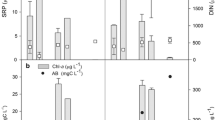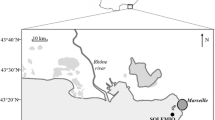Abstract
During an annual period the bacterial biomass (epifluorescence) and secondary production (methyl-3H-thymidine incorporation), as well as biomass (Chlorophyll) and algal primary production (incorporation of NaH14CO3) were studied in the Embalse del Río III Reservoir, Argentina. The relations between these variables and their responses to seasonal changes in water temperature were analyzed. A close relationship in seasonal patterns of algal primary production and bacterial secondary production was observed, with the estimated rates of bacterial production similar to that obtained by other authors in eutrophic lakes. Bacterial production was 17 to 46% of the primary production, thus, at 60% assimilation efficiency, the bacterioplankton would consume 28 to 77 % of the total fixed carbon. Seasonal trends in algal primary production and bacterial secondary production were mainly affected by temperature.
Similar content being viewed by others
References
Azam, F., T. Fenchel, J. G. Gray, L. A. Meyer-Riel & F. Thigstad, 1983. The ecological role of water-column microbes in the sea. Mar. Ecol. Prog. Ser. 10: 257–263.
Bell, R. T. & J. Kuparinen, 1984. Assessing phytoplankton and bacterioplankton production during early spring in lake Erken, Sweden. Appl. envir. Microbiol. 48: 1221–1230.
Bell, R. T., G. M. Ahlgren & I. Ahlgren, 1983. Estimating bacterioplankton production by measuring (3H)-thymidine incorporation in a eutrophic Swedish lake. Appl. envir. Microbiol. 45: 1709–1721.
Brock, T. D. & J. Clyne, 1984. Significance of algal excretory products for growth of epilimnetic bacteria. Appl. envir. Microbiol. 47: 731–734.
Calow, P., 1977. Conversion efficiencies in heterotrophic organisms. Biol. Rev. 52: 385–409.
Ducklow, H. W. & D. L. Kirchman, 1983. Bacterial dynamics and distribution during a spring diatom bloom in the Hudson River plume, USA. J. Plank. Res. 5: 333–355.
Fuhrman, J. A. & F. Azam, 1982. Thymidine incorporation as a measure of heterotrophic bacterioplankton production in marine surface waters: evaluation and field results. Mar. Biol. 66: 109–120.
Güde, H., B. Haibel & H. Muller, 1985. Development of planktonic bacterial populations in a water column of Lake Constance (Bodensee-Obersee). Arch. Hydrobiol. 105: 59–77.
Hobbie, J. E., R. J. Daley & S. Jasper, 1977. Use of Nuclepore filters for counting bacteria by fluorescence microscopy. Appl. envir. Microbiol. 33: 1225–1228.
Hobbie, J. E. & R. T. Wright, 1979. An assessment of quantitative measurements of aquatic microbes. Arch. Hydrobiol. Beih. Ergeb. Limnol. 13: 85–95.
Jones, J. G., 1979. A guide to methods for estimating microbial numbers and biomass in fresh water. Freshwater Biological Association, Windermere. 112 pp.
Kirchman, D., H. Ducklow & R. Mitchell, 1982. Estimates of bacterial growth rates and biomass. Appl. envir. Microbiol. 44: 1296–1307.
Larsson, U. & A. Hagström, 1979. Phytoplankton exudate release as an energy source for growth of pelagic bacteria. Mar. Biol. 52: 199–206.
Larsson, U. & A. Hagström, 1982. Fractionated phytoplankton primary production exudate release and bacterial production in a Baltic eutrophication gradient. Mar. Biol. 67: 57–70.
Lorenzen, C. J., 1967. Vertical distribution of chlorophyll and phaeopigments: spectrophotometric equations. Limnol. Oceanogr. 12: 343–346.
Lovell, C. R. & A. Konopka, 1985. Primary and bacterial production in two dimictic Indiana lakes. Appl. envir. Microbiol. 49: 485–491.
Mariazzi, A. A. & M. Romero, 1983. Estimation of the heterotrophic activity in three ecosystems with different trophic degrees. Ecosur. 10: 61–77.
Nagata, T., 1987. Production rate of planktonic bacteria in the north basin of Lake Biwa, Japan. Appl. envir. Microbiol. 53: 2872–2882.
Nakanishi, M., A. A. Mariazzi, V. H. Conzonno, E. Claverie, M. A. Di Siervi & M. Romero, 1985. Primary production studies on a reservoir, Embalse del Rio Tercero, R. Argentina. Mem. Fac. Sci., Kyoto Univ. Ser. Biol. 10: 49–62.
Newell, S. Y. & R. D. Fallon, 1982. Bacterial productivity in the water column and sediments of the Georgia (USA) coastal zone: estimates via direct counting and parallel measurement of thymidine incorporation. Microb. Ecol. 8: 33–46.
Pedrós-Alió, C. & T. D. Brock, 1982. Assessing biomass and production of bacteria in eutrophic Lake Mendota, Wisconsin. Appl. envir. Microbiol. 44: 203–218.
Riemann, B., 1985. Potential importance of fish predation and zooplankton grazing on natural populations of freshwater bacteria. Appl. envir. Microbiol. 50: 187–193.
Scavia, D., G. A. Laird & G. Fahnenstiel, 1986. Production of planktonic bacteria in Lake Michigan. Limnol. Oceanogr. 31: 612–626.
Scavia, D. & G. A. Laird, 1987. Bacterioplankton in Lake Michigan: Dynamics, controls and significance to carbon flux. Limnol. Oceanogr. 32: 1017–1033.
Søndergaard, M., B. Riemann & N. O. G. Jørgensen, 1985. Extracellular organic carbon (EOC) released by phytoplankton and bacterial production. Oikos 45: 323–332.
Steemann Nielsen, E., 1952. The use of radioactive carbon (14C) for measuring organic production in the sea. J. Cons. Int. Expl. Mar. 18: 117–140.
Watson, S. W., T. J. Novitsky, H. L. Quinby & F. W. Valois, 1977. Determination of bacterial number and biomass in the marine environment. Appl. envir. Microbiol. 33: 940–954.
Author information
Authors and Affiliations
Rights and permissions
About this article
Cite this article
Mariazzi, A.A., Di Siervi, M.A. & Donadelli, J.L. Bacterial secondary production and it relation with primary production in the Embalse del Río III Reservoir, Argentina. Hydrobiologia 211, 57–64 (1991). https://doi.org/10.1007/BF00008617
Received:
Revised:
Accepted:
Issue Date:
DOI: https://doi.org/10.1007/BF00008617




